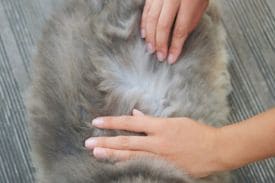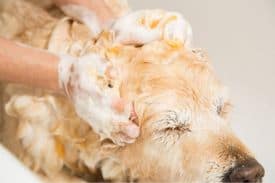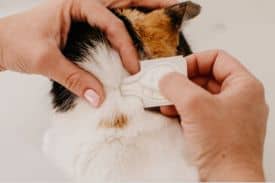Did you know that fleas are one of the most common parasites found on dogs, affecting around 60% of them at some point in their lives? If your furry friend is scratching incessantly and showing signs of discomfort, they likely have a flea infestation.
But don’t worry – you can take action to get rid of those pesky critters and bring relief to your pup. This article will guide you through the steps to eliminate fleas from your dog’s life and yours.
From recognizing the signs of fleas to treating your dog with flea shampoo, using medications and spot-on treatments, trying natural remedies for flea control, washing bedding and toys, treating your yard for fleas, preventing future infestations, seeking veterinary advice for severe cases, and maintaining regular prevention – we’ve got you covered!
Let’s dive in so you can serve your loyal companion by giving them a happy and itch-free life!
Key Takeaways
- Fleas on dogs are a common parasite affecting around 60% of dogs.
- Signs of fleas on dogs include itching, red bumps, scabs, hair loss, and hot spots.
- Flea shampoo treatment involves wetting the dog’s coat with warm water, applying shampoo and massaging it into the skin, paying extra attention to flea-prone areas, leaving the shampoo on for the recommended time, and rinsing thoroughly with warm water.
- Prevention is key, and regular grooming, washing bedding and toys, vacuuming, yard maintenance, and consulting a veterinarian for tailored treatments and preventative measures are important for getting rid of fleas on dogs.
Recognizing the Signs of Fleas on Your Dog

If your furry friend is constantly scratching and biting at their skin, they may suffer from fleas’ pesky presence. Identifying symptoms of fleas on your dog is crucial to provide them with the relief they need.
One common sign is excessive itching, especially around their tail, groin area, or armpits. You might also notice red bumps or scabs on their skin caused by flea bites. Another indication could be hair loss or hot spots where your dog has excessively scratched.
In some cases, dogs can develop a flea allergy, resulting in severe itching and inflammation. Suppose you suspect that your dog has fleas or a flea allergy. In that case, it’s important to consult a veterinarian who can recommend appropriate treatment options for your furry companion’s needs.
Treating Your Dog with Flea Shampoo

To effectively treat your furry friend for fleas, lather their coat with a soothing flea shampoo, which leaves them feeling refreshed and free from pesky pests.
Here are some key points to keep in mind when using flea shampoo:
- Use warm water to wet your dog’s coat thoroughly before applying the flea shampoo. This helps to create a rich lather that can reach all areas of their body.
- Massage the shampoo into your dog’s coat, paying extra attention to areas where fleas are commonly found, such as around the neck and tail.
- Leave the shampoo on for the recommended time specified on the bottle. This allows the active ingredients in the shampoo to kill fleas and their eggs effectively.
- Rinse your dog thoroughly with warm water until all traces of shampoo are gone.
While flea shampoos can be effective, it’s important to note that alternative flea treatments are available. Some dogs may experience potential side effects from certain flea shampoos, so it’s always a good idea to consult your veterinarian before starting any treatment.
Using Flea Medications and Spot-on Treatments

When using flea medications and spot-on treatments, it’s crucial to consult with your veterinarian for the best options that suit your furry friend’s needs and preferences.
Did you know that over 40% of pet owners prefer spot-on treatments for flea prevention? These treatments are easy to apply and provide long-lasting protection against fleas.
Spot-on treatments can be a great choice if you’re looking for alternatives to flea collars. They contain active ingredients that kill fleas on contact and prevent reinfestation.
If you prefer natural remedies, homemade flea repellents are also available. These can be made using ingredients like lemon juice, apple cider vinegar, or essential oils like lavender or peppermint.
Remember always to follow the instructions provided by your veterinarian or the product label when applying any flea medication or spot-on treatment to ensure the safety of your beloved pet.
Trying Natural Remedies for Flea Control
Instead of relying solely on traditional flea treatments, you can explore using natural remedies for flea control. Natural flea repellents are a safe and effective way to keep those pesky fleas away from your furry friend.
Here are three homemade flea sprays that won’t only repel fleas but will also leave your dog smelling fresh and clean:
- Lemon spray: Mix freshly squeezed lemon juice with water and pour it into a spray bottle. Spray this mixture onto your dog’s coat, avoiding the eyes and mouth. The citrus scent will repel fleas while leaving a refreshing aroma.
- Apple cider vinegar spray: Dilute apple cider vinegar with equal water and pour it into a spray bottle. Spray this solution onto your dog’s fur, covering all areas thoroughly. The acidic nature of apple cider vinegar helps repel fleas naturally.
- Lavender spray: Combine lavender essential oil with water in a spray bottle. Shake well before spraying onto your dog’s coat. Not only does lavender have a calming effect on dogs, but it also acts as a natural flea repellent.
Using these natural remedies, you can effectively control fleas without exposing your pet to harsh chemicals or toxins commonly found in traditional treatments.
Washing Your Dog’s Bedding and Toys
Ensure you regularly wash your furry friend’s bedding and toys to keep them clean and fresh-smelling. Washing your dog’s bedding removes fleas and their eggs that may be hiding in the fabric. Use hot water and mild detergent to kill any remaining fleas or larvae.
Check the manufacturer’s instructions for washing techniques, as some beds may require hand washing or specific temperature settings. After washing, dry the bedding thoroughly using high heat in the dryer. This will help eliminate any remaining fleas or eggs that may have survived the wash cycle.
Check if toys are machine-washable or need to be cleaned by hand using warm soapy water. Remember to dry them completely before returning them to your dog to prevent mold growth or reinfestation with fleas.
Vacuuming and Cleaning Your Home
Cleaning your home is fun and exciting, especially when it involves vacuuming. Not only does it make your house feel fresh and tidy, but it also helps remove fleas on dogs.
Here are three essential steps to deep clean your home and eliminate those pesky fleas:
- Vacuum thoroughly: Start by vacuuming every corner of your house, paying extra attention to areas where your furry friend spends most of their time. Don’t forget to clean the furniture, carpets, and rugs.
- Wash bedding and linens: Fleas love hiding in fabrics, so wash all your dog’s bedding, blankets, and toys in hot water with detergent. This will kill any fleas or eggs that might be lurking there.
- Consider professional pest control: If you’re dealing with a severe flea infestation, it might be worth seeking help from a professional pest control service. They have the expertise and tools needed to tackle stubborn flea problems effectively.
Following these steps and regular pet treatments ensures a flea-free home for you and your beloved pup.
Treating Your Yard for Fleas
Now that you’ve cleaned your home, it’s time to tackle the next step in getting rid of fleas on your dog – treating your yard. Remember, a thorough approach is essential to eliminate these pesky pests.
When treating your yard for fleas, several natural flea control options are available that will help protect your dog and the environment. One effective method is using nematodes, microscopic worms that feed on flea larvae in the soil.
Another option is creating a lemon spray by boiling sliced lemons and letting them steep overnight before applying it to your yard. Regularly mowing and raking your lawn can help reduce flea populations by removing their preferred hiding spots.
By implementing these natural methods, you’ll be well on your way to creating a flea-free environment for your furry friend!
| Natural Flea Control Options | Benefits |
|---|---|
| Nematodes | Feed on flea larvae |
| Lemon Spray | Repels fleas |
| Lawn Maintenance | Reduces flea populations |
Preventing Future Flea Infestations
Ensure a flea-free future for your beloved pet by taking proactive measures to safeguard against future infestations. Here are some tips to prevent reinfestation and natural flea prevention alternatives:
- Regularly vacuum your home, paying special attention to areas where your dog spends the most time.
- Wash your pet’s bedding and toys frequently using hot water.
- Trim tall grass or bushes in your yard, as fleas tend to hide in these areas.
- Use natural flea prevention methods such as essential oils or herbal sprays.
Following these steps can significantly reduce the chances of another flea infestation on your furry friend. Remember, prevention is always better than cure when protecting your pet from pesky fleas.
Seeking Veterinary Advice for Severe Infestations
To address the severity of the infestation, you should consider seeking veterinary advice for your pet’s flea problem, as they can provide specialized treatments that may be more effective than home remedies.
When it comes to severe flea infestations, it’s crucial to consult a veterinarian who can recommend the best course of action. They can access veterinary flea treatment options designed to combat these stubborn pests. These treatments are often stronger and more potent than over-the-counter products, ensuring a faster and more thorough eradication of fleas.
While home remedies can be helpful for mild infestations, they may not be enough for severe cases. A veterinarian will assess your dog’s condition and prescribe medication or suggest other treatment methods tailored to their needs.
Don’t hesitate to seek professional help when dealing with a severe flea infestation – your furry friend deserves the most effective care possible!
Maintaining Regular Flea Prevention for Your Dog
Ensure you consistently use flea prevention methods to keep your furry companion happy and healthy. Regular flea treatments are essential in maintaining a pest-free environment for your dog.
Start by consulting with your veterinarian to determine the best preventative measures. They may recommend topical treatments, oral medications, or flea collars that repel these pesky parasites. It’s important to follow their advice and administer the medicines as directed.
Additionally, regularly groom your dog by brushing their coat and checking for any signs of fleas or ticks. Vacuuming frequently and washing your dog’s bedding in hot water can also help eliminate fleas in your home.
Remember, prevention is key to keeping fleas away from your beloved pet!
Frequently Asked Questions
Can I use the same flea shampoo for my dog and cat?
You can use the same flea shampoo for your dog and cat. The pros are convenience and cost-effectiveness. However, there are cons like different sensitivities and allergies between species. Always consult a vet before using any product on multiple pets.
How long does it take for flea medication to start working?
You should start seeing results from flea medication within a few hours to a few days. Consider speaking with your veterinarian about other options if you want an alternative.
Are there any natural remedies for flea control that are safe for puppies?
To safely treat fleas on puppies, you can use a natural flea treatment like homemade flea spray. Choosing safe ingredients for puppies is important, and consult your veterinarian for guidance.
Can I wash my dog’s bedding and toys with regular detergent?
You can wash your dog’s bedding and toys with regular detergent. However, it’s important to note that using a flea-specific detergent can help eliminate any remaining fleas or eggs on the items.
How often should I vacuum and clean my home to eliminate fleas?
To keep your home flea-free, vacuum and clean at least once a week. Consider using a flea collar for your dog as an additional precaution. Your dedication to cleanliness will help protect both you and your furry friend.
Conclusion
In conclusion, “The Ultimate Guide on How to Get Rid of Fleas on Dogs” is your comprehensive source for tackling this pesky problem, ensuring a happier, healthier life for your four-legged friend. Remember, every dog deserves a flea-free life.
At Bone Voyage Dog Rescue, we firmly believe in this ethos. Adopting a dog is about welcoming a new family member who brings joy, love, and, occasionally, minor challenges like fleas. Armed with the knowledge from our guide, you’re now equipped to handle these issues head-on.
So why not take the next step? Open your heart and home to a furry friend who needs you. Visit our website today to meet the canine companions waiting for their forever homes. Because at Bone Voyage Dog Rescue, we’re not just rescuing dogs. Together, we’re creating happy, healthy pet families.
